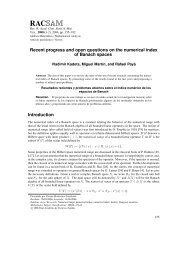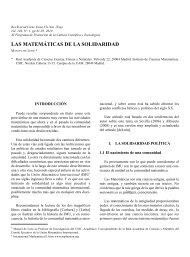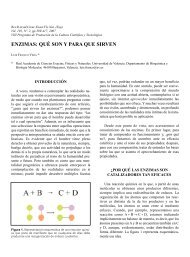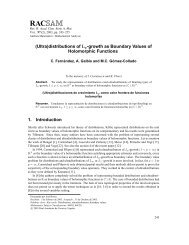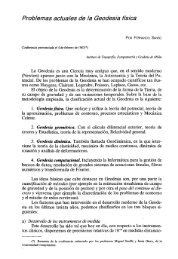On the defining polynomials of maximal real cyclotomic extensions
On the defining polynomials of maximal real cyclotomic extensions
On the defining polynomials of maximal real cyclotomic extensions
Create successful ePaper yourself
Turn your PDF publications into a flip-book with our unique Google optimized e-Paper software.
M. Aranés and A. ArenasX −1 ) is obviously a monic polynomial in X with rational coefficients, vanishing when X = ζ and <strong>of</strong>degree p ν−1 (p − 1), we see thatWe writeX pν−1 (p−1)/2 Ψ(X + X −1 ) = Φ(X) (2)Ψ p ν (X) = Ψ(X) = a m X m + a m−1 X m−1 + · · · + a 1 X + a 0 (3)where, <strong>of</strong> course a m = 1, and m = 1 2 ϕ(pν ) = p ν−1 (p − 1)/2.This paper is devoted to <strong>the</strong> evaluation <strong>of</strong> <strong>the</strong> coefficients a m−1 , . . . , a 1 , a 0 .2 PreliminariesIn order to achieve our aim we first proceed to expand <strong>the</strong> relation (2) using <strong>the</strong> notation <strong>of</strong> (3):⎛⎛⎞∑m (Φ(X) = X m a i X + 1 ) i m∑i∑(= a i X m−i ⎝ i2m∑∑(XX j)2(i−j) ⎠ = ⎜i⎝ a iji=0i=0j=0t=0i−2j=t−m0≤j≤i≤m⎞)⎟⎠ Xt .This shows that a 0 , . . . , a m is a solution <strong>of</strong> <strong>the</strong> system <strong>of</strong> linear equations∑( ) ia i = b t , (4)ji−2j=t−m0≤j≤i≤mwhere by (1), for 0 ≤ t ≤ ϕ(p ν ) = 2m,⎧⎨1, if t = p ν−1 l, 0 ≤ l < pb t =⎩0, o<strong>the</strong>rwise,For <strong>the</strong> sake <strong>of</strong> clarity we rewrite <strong>the</strong> preceding system <strong>of</strong> equations (4) more explicitly as follows:⎧k/2∑( )m − k + 2ja m−k+2j , for k = 2, 4, . . . , r.⎪⎨jj=0b 2m−k =(5)(k−1)/2∑( )m − k + 2j⎪⎩a m−k+2j , for k = 1, 3, . . . , s.jj=0where r = m, s = m − 1, if p ≡ 1 (mod 4) or p = 2; and r = m − 1, s = m in <strong>the</strong> case p ≡ 3 (mod 4).In order to get <strong>the</strong> explicit solution <strong>of</strong> (5) we are led to compute <strong>the</strong> following determinants <strong>of</strong> order k,for strictly positive integers r, k:( r+2(k−1)) ( r+2(k−2))100 0 · · · · · · 0( r+2(k−1)) ( r+2(k−2)) ( r+2(k−3))2100 · · · · · · 0. .... .. .A r (k) :=....... ..... 0( r+2(k−1)) ( r+2(k−2)) ( r+2(k−3)) ( r+2(k−4))( k−1k−2k−3k−4· · · · · · r ( 0)∣ r+2(k−1)) ( r+2(k−2)) ( r+2(k−3)) ( r+2(k−4))(kk−1k−2k−4· · · · · · r 1)∣184





